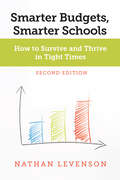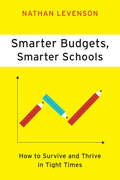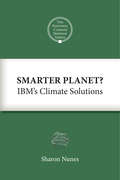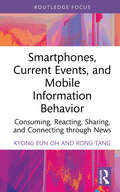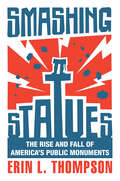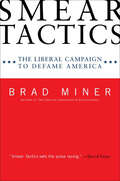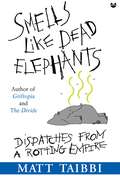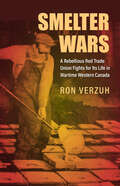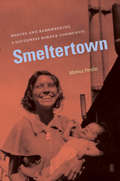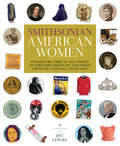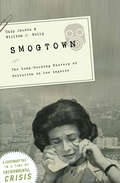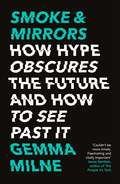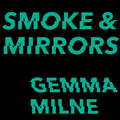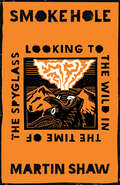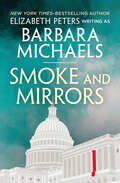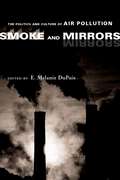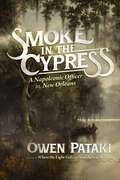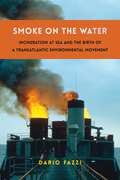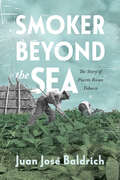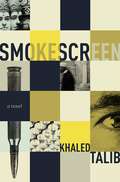- Table View
- List View
Smarter Budgets, Smarter Schools, Second Edition: How to Survive and Thrive in Tight Times
by Nathan LevensonIn the updated edition of Smarter Budgets, Smarter Schools, Nathan Levenson proposes fresh strategies for more efficient, equitable resource allocation within school districts.Budgets, according to Levenson, can be a surprisingly powerful lever for improved student achievement outcomes and equity. Readers of this revised edition will find practical advice for funding equity initiatives and social-emotional services, among other student needs. Levenson also discusses how to accommodate common, necessary school expenses and district improvement measures such as capital purchases, personnel costs, and campus renovations within tight funding models. The key is creativity: Levenson invites readers to shift their mindsets and embrace innovative ideas for using limited resources strategically.An indispensable guide, Smarter Budgets, Smarter Schools delivers proven, successful practices for school leaders—superintendents, central office leaders, building principals, and school board members—who hope to make smarter, better informed financial decisions and stretch declining district budgets. It outlines budget management tactics for working around financial constraints brought on by shrinking tax revenues, rising health care and pension costs, and increased special education needs. The book also addresses how to manage declining or increasing enrollment numbers.Throughout this useful and timely work, Levenson provides real-world examples, critical worksheets, and actionable suggestions to help decision-makers apply these concepts and realize a greater academic return on their investments.
Smarter Budgets, Smarter Schools: How To Survive and Thrive in Tight Times
by Nathan LevensonArmed with real-world examples and out-of-the-box ideas, Nathan Levenson challenges conventional thinking about school budgeting and offers practical, actionable advice for school superintendents, central office leaders, building principals, and school board members.Virtually every school district in the nation is experiencing an extended period of financial constraints. Shrinking tax revenue, decreasing federal stimulus funds, rising health care and pension costs, and growing high-need student populations will continue to test superintendents and school boards as they seek to prepare students for a globally competitive environment.
Smarter Growth: Activism and Environmental Policy in Metropolitan Washington (The City in the Twenty-First Century)
by John H. SpiersSuburban sprawl has been the prevailing feature—and double-edged sword—of metropolitan America's growth and development since 1945. The construction of homes, businesses, and highways that were signs of the nation's economic prosperity also eroded the presence of agriculture and polluted the environment. This in turn provoked fierce activism from an array of local, state, and national environmental groups seeking to influence planning and policy. Many places can lay claim to these twin legacies of sprawl and the attendant efforts to curb its impact, but, according to John H. Spiers, metropolitan Washington, D.C., in particular, laid the foundations for a smart growth movement that blossomed in the late twentieth century.In Smarter Growth, Spiers argues that civic and social activists played a key role in pushing state and local officials to address the environmental and fiscal costs of growth. Drawing on case studies including the Potomac River's cleanup, local development projects, and agricultural preservation, he identifies two periods of heightened environmental consciousness in the early to mid-1970s and the late 1990s that resulted in stronger development regulations and land preservation across much of metropolitan Washington.Smarter Growth offers a fresh understanding of environmental politics in metropolitan America, giving careful attention to the differences between rural, suburban, and urban communities and demonstrating how public officials and their constituents engaged in an ongoing dialogue that positioned environmental protection as an increasingly important facet of metropolitan development over the past four decades. It reveals that federal policies were only one part of a larger decision-making process—and not always for the benefit of the environment. Finally, it underscores the continued importance of grassroots activists for pursuing growth that is environmentally, fiscally, and socially equitable—in a word, smarter.
Smarter New York City: How City Agencies Innovate
by André Corrêa D’AlmeidaInnovation is often presented as being in the exclusive domain of the private sector. Yet despite widespread perceptions of public-sector inefficiency, government agencies have much to teach us about how technological and social advances occur. Improving governance at the municipal level is critical to the future of the twenty-first-century city, from environmental sustainability to education, economic development, public health, and beyond. In this age of acceleration and massive migration of people into cities around the world, this book explains how innovation from within city agencies and administrations makes urban systems smarter and shapes life in New York City.Using a series of case studies, Smarter New York City describes the drivers and constraints behind urban innovation, including leadership and organization; networks and interagency collaboration; institutional context; technology and real-time data collection; responsiveness and decision making; and results and impact. Cases include residential organic-waste collection, an NYPD program that identifies the sound of gunshots in real time, and the Vision Zero attempt to end traffic casualties, among others. Challenging the usefulness of a tech-centric view of urban innovation, Smarter New York City brings together a multidisciplinary and integrated perspective to imagine new possibilities from within city agencies, with practical lessons for city officials, urban planners, policy makers, civil society, and potential private-sector partners.
Smarter Planet?: IBM's Climate Solutions
by Eban Goodstein Sharon NunesOn October 19, 2011, Sharon Nunes participated in The National Climate Seminar, a series of webinars sponsored by Bard College's Center for Environmental Policy. The online seminars provide a forum for leading scientists, writers, and other experts to talk about critical issues regarding climate change. The series also opens a public conversation, inviting participants to ask questions and contribute their own thoughts. Sharon Nunes is Vice President of the Smarter Cities Strategy & Solutions program at IBM, working with municipal leaders to manage urban systems more efficiently. In her lecture, Nunes discussed the ability of smart grids and other information technology to save energy, time, and costs. Questions focused on the barriers to implementing these systems, and Nunes addressed ongoing challenges as well as successful programs. This E-ssential is an edited version of Nunes' talk and the subsequent question and answer session. While some material has been cut and some language modified for clarity, the intention was to retain the substance of the original discussion.
Smartphones, Current Events and Mobile Information Behavior: Consuming, Reacting, Sharing, and Connecting through News
by Kyong Eun Oh Rong TangSmartphones and Information on Current Events provides unprecedented insights into young people’s news consumption patterns and the ecology of mobile news. Advancing our knowledge of mobile behaviour, the book also highlights the ways in which mobile news impacts the lives of the general public. Using a multi-faceted research model on mobile news consumption behaviour, Oh and Tang examined a wide spectrum of mobile news consumption activities, outlined the key characteristics of mobile news, as well as captured users’ near real-time evaluation of and emotional reactions to news stories. The book also shows that the process of using smartphones to receive, read, find, share, and store news stories has resulted in new behavioural patterns that enable people to consume news in a multifaceted way. Analyzing the extent and various methods of mobile news sharing can, Oh and Tang argue, help us understand how such exchanges reshape contemporary society. Demonstrating that mobile news consumption is now an integral part of people’s daily lives, the book clearly shows that its impact on people’s day-to-day activities, and their political and social lives, cannot be underestimated. Smartphones and Information on Current Events will be useful to scholars, students, and practitioners who are studying library and information science, journalism and media, digital communication, user behaviour, information technology, human-computer interaction, marketing, political science, psychology, and sociology.
Smashing Statues: The Rise and Fall of America's Public Monuments
by Erin L. ThompsonA leading expert on the past, present, and future of public monuments in America. An urgent and fractious national debate over public monuments has erupted in America. Some people risk imprisonment to tear down long-ignored hunks of marble; others form armed patrols to defend them. Why do we care so much about statues? Which ones should stay up and which should come down? Who should make these decisions, and how? Erin L. Thompson, the country’s leading expert in the tangled aesthetic, legal, political, and social issues involved in such battles, brings much-needed clarity in Smashing Statues. She lays bare the turbulent history of American monuments and its abundant ironies, from the enslaved man who helped make the statue of Freedom that tops the United States Capitol, to the fervent Klansman fired from sculpting the world’s largest Confederate monument—who went on to carve Mount Rushmore. And she explores the surprising motivations behind contemporary flashpoints, including the toppling of a statue of Columbus at the Minnesota State Capitol, the question of who should be represented on the Women’s Rights Pioneers Monument in Central Park, and the decision by a museum of African American culture to display a Confederate monument removed from a public park. Written with great verve and informed by a keen sense of American history, Smashing Statues gives readers the context they need to consider the fundamental questions for rebuilding not only our public landscape but our nation as a whole: Whose voices must be heard, and whose pain must remain private?
Smear Tactics: The Liberal Campaign to Defame America
by Brad MinerIn this spirited survey of liberal lies and dirty tricks, Brad Miner, one of America's leading conservative insiders, offers a look at the American liberal tradition of slander, insult, and character assassination throughout history. Smear Tactics mines both today's papers and the classic campaigns of history for tales of liberal deception and manipulation. Tracing smears from the early days of our nation right through the run-up to the 2008 elections, Miner highlights the Left's most atrocious campaigns against:Soldiers: The media's attacks on our troops, from Vietnam to IraqThe Faithful: The Left's campaign to vilify Christians in American lifeEntrepreneurs: Is the American Dream dead? The Left says yes, and Girl Scout cookies, Wal-Mart, and Legos have all played a part.President Bush: He caused global warming and Hurricane Katrina? Smears against the man the Left loves to hate. As Brad Miner shows, American politics has never been a sport for gentlemen—but recent campaigns have proven dirtier than ever, full of negative ads, rumormongering, and worse. With the coming election a wide-open race, full of polarizing candidates of all stripes, the mud is about to start flying across the American landscape, and in Smear Tactics Brad Miner returns the fire—with a vengeance.
Smells like Dead Elephants: Dispatches from a Rotting Empire
by Matt TaibbiMatt Taibbi is notorious as a journalistic agitator, a stone thrower, a "natural provocateur" (Salon. com). His scathing, vibrant prose shines an unflinching spotlight on the corruption, dishonesty, and sheer laziness of our leaders. Smells Like Dead Elephants brings together Taibbi's most incisive, intense, and hilarious work from his "Road Work" column in Rolling Stone. Written over the last two years, a period in our history with no shortage of outrages to compel Taibbi's pen, these pieces paint a shocking portrait of our government at work--or, as Taibbi points out in "The Worst Congress Ever," rarely working. "In the Sixties and Seventies, Congress met an average of 162 days a year. The 109th Congress set the all-time record for fewest days worked by a U.S. Congress: 93. Figuring for half-days, in fact, the 109th Congress probably worked almost two months less than the notorious 'Do-Nothing' Congress of 1948". Taibbi has plenty to say about George W. Bush, Jack Abramoff, Tom DeLay, and all the rest, but he doesn't just hit inside the Beltway. He gets involved in the action, infiltrating Senator Conrad Burns's birthday party under disguise as a lobbyist for a fictional oil firm that wants to drill in the Grand Canyon. He floats into apocalyptic post-Katrina New Orleans in a dinghy with Sean Penn. He goes to Iraq as an embedded reporter, where he witnesses the mind-boggling dysfunction of our occupation and spends three nights in Abu Ghraib prison. And he reports from two of the most bizarre and telling trials in recent memory: California v. Michael Jackson and the evolution-vs.-intelligent-design trial in Harrisburg, Pennsylvania. A brilliant collection from one of the most entertaining political writers of today, Smells Like Dead Elephants is a stylish record of the offenses of the Bush years.
Smelter Wars: A Rebellious Red Trade Union Fights for Its Life in Wartime Western Canada (Canadian Social History Series)
by Ron VerzuhIn 1938, the Congress of Industrial Organizations (CIO) sent communist union organizer Arthur "Slim" Evans to the smelter city of Trail, British Columbia, to establish Local 480 of the International Union of Mine, Mill and Smelter Workers. Six years later the local was recognized as the legal representative of more than 5,000 workers at a smelter owned by the powerful Consolidated Mining and Smelting Company of Canada. But the union’s fight for survival had only just begun. Smelter Wars unfolds that historic struggle, offering glimpses into the political, social, and cultural life of the semi-rural, single-industry community. Hindered by economic depression, two World Wars, and Cold War intolerance, Local 480 faced fierce corporate, media, and religious opposition at home. Ron Verzuh draws upon archival and periodical sources, including the mainstream and labour press, secret police records, and oral histories, to explore the CIO’s complicated legacy in Trail as it battled a wide range of antagonists: a powerful employer, a company union, local conservative citizens, and Cooperative Commonwealth Federation (CCF) leadership. More than the history of a union, Smelter Wars is a cultural study of a community shaped by the dominance of a world-leading industrial juggernaut set on keeping the union drive at bay.
Smeltertown
by Monica PeralesCompany town. Blighted community. Beloved home. Nestled on the banks of the Rio Grande, at the heart of a railroad, mining, and smelting empire, Smeltertown--La Esmelda, as its residents called it--was home to generations of ethnic Mexicans who labored at the American Smelting and Refining Company in El Paso, Texas. Using newspapers, personal archives, photographs, employee records, parish newsletters, and interviews with former residents, including her own relatives, Monica Perales unearths the history of this forgotten community. Spanning almost a century,Smeltertowntraces the birth, growth, and ultimate demise of a working class community in the largest U. S. city on the Mexican border and places ethnic Mexicans at the center of transnational capitalism and the making of the urban West. Perales shows that Smeltertown was composed of multiple real and imagined social worlds created by the company, the church, the schools, and the residents themselves. Within these dynamic social worlds, residents forged permanence and meaning in the shadow of the smelter's giant smokestacks. Smeltertownprovides insight into how people and places invent and reinvent themselves and illuminates a vibrant community grappling with its own sense of itself and its place in history and collective memory.
Smiling Down the Line
by Bob RussellJust as textile mills and automotive assembly plants have symbolized previous economic eras, the call centre stands as a potent reminder of the importance of information in contemporary economies. Bob Russell's Smiling Down the Line theorizes call centre work as info-service employment and looks at the effects of ever-changing technologies on service work, its associated skills, and the ways in which it is managed. Russell also considers globalization and contemporary managerial practices as centres are outsourced to poorer countries such as India and as new forms of management are introduced, refined, and discarded.Invoking extensive labour force surveys and interviews from Australia and India, Russell examines employee representation, work intensity, stress, emotional labour, and job skills in the call centre work environment. The cross-national approach of Smiling Down the Line highlights the effects of globalization and scrutinizes the similarities and differences that exist in info-service work between different industries and in different countries.
Smithsonian American Women: Remarkable Objects and Stories of Strength, Ingenuity, and Vision from the National Collection
by Smithsonian InstitutionAn inspiring and surprising celebration of U.S. women's history told through Smithsonian artifacts illustrating women's participation in science, art, music, sports, fashion, business, religion, entertainment, military, politics, activism, and more.This book offers a unique, panoramic look at women's history in the United States through the lens of ordinary objects from, by, and for extraordinary women. Featuring more than 280 artifacts from 16 Smithsonian museums and archives, and more than 135 essays from 95 Smithsonian authors, this book tells women's history as only the Smithsonian can. Featured objects range from fine art to computer code, from First Ladies memorabilia to Black Lives Matter placards, and from Hopi pottery to a couch from the Oprah Winfrey show. There are familiar objects--such as the suffrage wagon used to advocate passage of the 19th Amendment and the Pussy Hat from the 2016 Women's March in DC--as well as lesser known pieces revealing untold stories. Portraits, photographs, paintings, political materials, signs, musical instruments, sports equipment, clothes, letters, ads, personal posessions, and other objects reveal the incredible stories of such amazing women as Phillis Wheatley, Julia Child, Sojourner Truth, Mary Cassatt, Madam C. J. Walker, Amelia Earhart, Eleanor Roosevelt, Mamie Till Mobley, Dolores Clara Fernández Huerta, Phyllis Diller, Celia Cruz, Sandra Day O'Connor, Billie Jean King, Sylvia Rivera, and so many more.Together with illuminating text, these objects elevate the importance of American women in the home, workplace, government, and beyond. Published to commemorate the centennial of the 19th Amendment granting women the right to vote, Smithsonian American Women is a deeply satisfying read and a must-have reflection on how generations of women have defined what it means to be recognized in both the nation and the world.
Smogtown: The Lung-Burning History of Pollution in Los Angeles
by Chip Jacobs William J. Kelly“A zany and provocative cultural history” of LA’s infamous air pollution and the struggle to combat it from the 1940s to today (Kirkus).The smog beast wafted into downtown Los Angeles on July 26, 1943. Nobody knew what it was. Secretaries rubbed their eyes. Traffic cops seemed to disappear in the mysterious haze. Were Japanese saboteurs responsible? A reckless factory? The truth was much worse—it came from within, from Southern California’s burgeoning car-addicted, suburban lifestyle. Smogtown is the story of pollution, progress, and how an optimistic people confronted the epic struggle against airborne poisons barraging their hometowns. There are scofflaws and dirty deals aplenty, plus murders, suicides, and an ever-present paranoia about mass disaster. California based journalists Chip Jacobs and William J. Kelly highlight the bold personalities involved, the corporate-tainted science, the terrifying health costs, the attempts at cleanup, and how the smog battle helped mold the modern-day culture of Los Angeles.
Smoke & Mirrors: How Hype Obscures the Future and How to See Past It
by Gemma Milne'Stop following the news until you've read Gemma Milne's persuasive analysis of the hype and bullshit that distort our understanding of emerging science. As she shows, the starting point to grasping the genuine opportunities of AI, life sciences and climate tech is a healthy dose of critical thinking'David Rowan, founding editor of WIRED UK and author of Non-Bullshit Innovation: Radical Ideas from the World's Smartest Minds'Couldn't be more timely. Fascinating and vitally important'Jamie Bartlett, author of The People Vs Tech'A much-needed blast of fresh air! Gemma Milne expertly shows us how to separate the truth from the hype surrounding the emerging techs of today, and those of the near-tomorrow'Lewis Dartnell, author of Origins: How the Earth Made Us'I loved this book! This is exactly the sort of sceptical, cut-through-the crap-but-still-excited-about-what's-emerging book around tech innovation that's sorely needed, yet is so hard to find . . . essential reading for anyone who's serious about how real-world advances might be effectively harnessed to build a better future'Dr Andrew Maynard, scientist and author of Films from the Future and Future Rising'[A] vital contribution in a world where technological progress promises so much, but too often disappoints. If, like me, you believe that advances in science and technology are our best hope for solving the grand challenges of our times, this book is the indispensable guide to avoiding the mirages and the charlatans along the way'Matt Clifford, co-founder and CEO of Entrepreneur First'A refreshingly grown-up, clear-headed look at the interaction between science, technology and the media - readable without being dumbed down, acknowledging complexities without being heavy'Tom Chivers, author of The AI Does Not Hate You'ROBOTS WILL STEAL YOUR JOB!''AI WILL REVOLUTIONISE FARMING!''GENETIC EDITING WILL CURE CANCER!'Bombastic headlines about science and technology are nothing new. To cut through the constant stream of information and misinformation on social media, or grab the attention of investors, or convince governments to take notice, strident headlines or bold claims seem necessary to give complex, nuanced information some wow factor.But hype has a dark side, too.It can mislead. It can distract. It can blinker us from seeing what is actually going on.From AI, quantum computing and brain implants, to cancer drugs, future foods and fusion energy, science and technology journalist Gemma Milne reveals hype to be responsible for fundamentally misdirecting or even derailing crucial progress.Hype can be combated and discounted, though, if you're able to see exactly where, how and why it is being deployed.This book is your guide to doing just that.
Smoke & Mirrors: How Hype Obscures the Future and How to See Past It
by Gemma Milne'Stop following the news until you've read Gemma Milne's persuasive analysis of the hype and bullshit that distort our understanding of emerging science. As she shows, the starting point to grasping the genuine opportunities of AI, life sciences and climate tech is a healthy dose of critical thinking'David Rowan, founding editor of WIRED UK and author of Non-Bullshit Innovation: Radical Ideas from the World's Smartest Minds'Couldn't be more timely. Fascinating and vitally important'Jamie Bartlett, author of The People Vs Tech'A much-needed blast of fresh air! Gemma Milne expertly shows us how to separate the truth from the hype surrounding the emerging techs of today, and those of the near-tomorrow'Lewis Dartnell, author of Origins: How the Earth Made Us'I loved this book! This is exactly the sort of sceptical, cut-through-the crap-but-still-excited-about-what's-emerging book around tech innovation that's sorely needed, yet is so hard to find . . . essential reading for anyone who's serious about how real-world advances might be effectively harnessed to build a better future'Dr Andrew Maynard, scientist and author of Films from the Future and Future Rising'[A] vital contribution in a world where technological progress promises so much, but too often disappoints. If, like me, you believe that advances in science and technology are our best hope for solving the grand challenges of our times, this book is the indispensable guide to avoiding the mirages and the charlatans along the way'Matt Clifford, co-founder and CEO of Entrepreneur First'A refreshingly grown-up, clear-headed look at the interaction between science, technology and the media - readable without being dumbed down, acknowledging complexities without being heavy'Tom Chivers, author of The AI Does Not Hate You'ROBOTS WILL STEAL YOUR JOB!''AI WILL REVOLUTIONISE FARMING!''GENETIC EDITING WILL CURE CANCER!'Bombastic headlines about science and technology are nothing new. To cut through the constant stream of information and misinformation on social media, or grab the attention of investors, or convince governments to take notice, strident headlines or bold claims seem necessary to give complex, nuanced information some wow factor.But hype has a dark side, too.It can mislead. It can distract. It can blinker us from seeing what is actually going on.From AI, quantum computing and brain implants, to cancer drugs, future foods and fusion energy, science and technology journalist Gemma Milne reveals hype to be responsible for fundamentally misdirecting or even derailing crucial progress.Hype can be combated and discounted, though, if you're able to see exactly where, how and why it is being deployed.This book is your guide to doing just that.
Smoke & Mirrors: How Hype Obscures the Future and How to See Past It
by Gemma Milne'Stop following the news until you've read Gemma Milne's persuasive analysis of the hype and bullshit that distort our understanding of emerging science. As she shows, the starting point to grasping the genuine opportunities of AI, life sciences and climate tech is a healthy dose of critical thinking'David Rowan, founding editor of WIRED UK and author of Non-Bullshit Innovation: Radical Ideas from the World's Smartest Minds'Couldn't be more timely. Fascinating and vitally important'Jamie Bartlett, author of The People Vs Tech'A much-needed blast of fresh air! Gemma Milne expertly shows us how to separate the truth from the hype surrounding the emerging techs of today, and those of the near-tomorrow'Lewis Dartnell, author of Origins: How the Earth Made Us'I loved this book! This is exactly the sort of sceptical, cut-through-the crap-but-still-excited-about-what's-emerging book around tech innovation that's sorely needed, yet is so hard to find . . . essential reading for anyone who's serious about how real-world advances might be effectively harnessed to build a better future'Dr Andrew Maynard, scientist and author of Films from the Future and Future Rising'[A] vital contribution in a world where technological progress promises so much, but too often disappoints. If, like me, you believe that advances in science and technology are our best hope for solving the grand challenges of our times, this book is the indispensable guide to avoiding the mirages and the charlatans along the way'Matt Clifford, co-founder and CEO of Entrepreneur First'A refreshingly grown-up, clear-headed look at the interaction between science, technology and the media - readable without being dumbed down, acknowledging complexities without being heavy'Tom Chivers, author of The AI Does Not Hate You'ROBOTS WILL STEAL YOUR JOB!''AI WILL REVOLUTIONISE FARMING!''GENETIC EDITING WILL CURE CANCER!'Bombastic headlines about science and technology are nothing new. To cut through the constant stream of information and misinformation on social media, or grab the attention of investors, or convince governments to take notice, strident headlines or bold claims seem necessary to give complex, nuanced information some wow factor.But hype has a dark side, too.It can mislead. It can distract. It can blinker us from seeing what is actually going on.From AI, quantum computing and brain implants, to cancer drugs, future foods and fusion energy, science and technology journalist Gemma Milne reveals hype to be responsible for fundamentally misdirecting or even derailing crucial progress.Hype can be combated and discounted, though, if you're able to see exactly where, how and why it is being deployed.This book is your guide to doing just that.
Smoke Hole: Looking to the Wild in the Time of the Spyglass
by Martin Shaw"With potent, lyrical language and a profound knowledge of storytelling, Shaw encourages and illuminates the mythic in our own lives. He is a modern-day bard." – Madeline Miller, author of Circe and The Song of Achilles At a time when we are all confronted by not one, but many crossroads in our modern lives—identity, technology, trust, politics, and a global pandemic—celebrated mythologist and wilderness guide Martin Shaw delivers Smoke Hole: three metaphors to help us understand our world, one that is assailed by the seductive promises of social media and shadowed by a health crisis that has brought loneliness and isolation to an all-time high. Smoke Hole is a passionate call to arms and an invitation to use these stories to face the complexities of contemporary life, from fake news, parenthood, climate crises, addictive technology and more. Shaw urges us to reclaim our imagination and untangle ourselves from modern menace, letting these tales be our guide. More Praise: "I can still remember the first time I heard Martin Shaw tell a story. The tale that emerged was like a living thing, bounding around, throwing itself at us there listening. I had never heard anything like it before." – Paul Kingsnorth, Booker shortlisted author of The Wake "Martin Shaw’s work is so very beautiful. A new animal. His love of images is deep and contagious." – Coleman Barks, author of The Essential Rumi "Through feral tales and poetic exegesis, Martin Shaw makes you re-see the world, as a place of adventure, and of initiation, as perfect home, and as perfectly other. What a gift." – David Keenan, author of Xstabeth "Shaw has so much wisdom and knowledge about the old stories, it emanates from his pores." – John Densmore, The Doors
Smoke Hole: Looking to the Wild in the Time of the Spyglass
by Martin Shaw"A modern-day bard."—Madeline Miller, author of Circe and The Song of Achilles"Shaw has so much wisdom and knowledge about the old stories, it emanates from his pores."—John Densmore, The Doors"Through feral tales and poetic exegesis, Martin Shaw makes you re-see the world, as a place of adventure and of initiation, as perfect home and as perfectly other. What a gift."—David Keenan, author of Xstabeth"I can still remember the first time I heard Martin Shaw tell a story. The tale that emerged was like a living thing, bounding around, throwing itself at us there listening. I had never heard anything like it before."—Paul Kingsnorth, Booker shortlisted author of The WakeToday, as we are confronted by not one, but many crossroads in our lives – identity, technology, love, seduction, politics – celebrated mythologist and wilderness guide Martin Shaw delivers Smoke Hole – three ancient myths that serve as metaphors for our world today. Assailed by the seductive promises of social media and shadowed by a pandemic that brought loneliness to an all-time high, Martin argues that we are losing our sense of direction, our sense of self.He invites us to use these stories to help find &‘a commons for the imagination, a place to breathe deeper, feel steadier and become acquainted with rapture.&’ Smoke Hole is a passionate call to arms and an invitation to use these stories to face the complexities of contemporary life, from fake news to parenthood, climate crises, addictive technology and more.
Smoke and Mirrors
by Elizabeth PetersAn idealistic young woman finds working a political campaign can be murder in this romantic suspense novel by &“a master storyteller&” (Mary Higgins Clark). Young Erin Hartsock arrives in Washington, DC, with ambition—and little interest in politics. However, when she&’s offered a position on a congresswoman&’s campaign for the Senate, she&’s more than happy to flee her dead-end job to take on what she expects will be boring administrative work . . . But as the campaign heats up, disturbing events follow. There&’s a string of dangerous fires, a violent attack, and a seemingly accidental death. Erin begins to wonder about her colleagues all while they grow suspicious of her. Someone&’s got a secret—and with the election looming, Erin must quickly uncover who&’s behind the chaos before she becomes a prime candidate for murder. Previously published under the pseudonym Barbara Michaels Praise for New York Times–bestseller Elizabeth Peters and Smoke and Mirrors &“[Peters] delivers another sure-fire winner in this romantic adventure set in the smoky, deceptive arena of American politics.&” —Publishers Weekly
Smoke and Mirrors: The Politics and Culture of Air Pollution
by E. Melanie DuPuisWho gets to breathe clean air? Who benefits from the cheaper products produced with dirty air? The answers, as the contributors to Smoke and Mirrors tell us, are sometimes as gray as the air itself. From the coal factory chimneys in Manchester in the late nineteenth century to the smog hanging over Los Angeles in the late twentieth century, air pollution has long been one of the greatest threats to our environment. In this important collection of original essays, the leading environmental scientists and social scientists examine the politics of air pollution policies and help us to understand the ways these policies have led to, idiosyncratic, effective, ineffective, and even disastrous choices about what we choose to put into and take out of the air. Offering historical, contemporary and cross-national perspectives, this volume provides a refreshing new approach to understanding how air pollution policies have evolved over time.
Smoke in the Cypress: A Napoleonic Officer in New Orleans
by Owen PatakiA veteran of the Napoleonic Wars must travel from revolution-torn France to Louisiana to rescue a young noblewoman, but he is quickly ensnared in a complex web of political intrigue and violence in this thrilling historical fiction adventure.As the War of 1812 rages across early 19th-century America, Marcel Moreau, wounded in service with Napoleon's Grand Armée, must journey to New Orleans to find Celeste de Beaumais, a young aristocrat who has fled the aftermath of the French Revolution and has settled herself on a sprawling Louisiana plantation. Standing in Moreau's way are various factions in and around the historic French Quarter—soldiers, slave hunters, marooned slaves, and Jean Lafitte's notorious Baratarian pirates—all of whom have their own interests and enemies. As he ventures deeper into the city and the vast cypress swamps beyond, encountering elements of Creole culture and Louisiana voodoo, Moreau will find that circumstances are much more complex—and dangerous—than he could have imagined. Meanwhile, a massive English fleet appears on the horizon, causing panic in the city and desperation from the outgunned and outnumbered Louisiana militia. Hoping to benefit from his years of military experience with Napoleon's Grande Armée, these French-speaking Creole farmers and townsfolk, and their American allies, enlist Moreau to help train them for the coming battle of New Orleans. As he does what he can to help this motley resistance movement—led by General Andrew Jackson and bolstered by Jean Lafitte's Baratarians—Moreau soon comes up against another enemy. With the city's eyes on the battlefield, a ruthless plantation master plots his own designs. But those who've escaped his clutches have no plans to return to a life in chains and have formed their own resistance. Moreau must now decide where his experience and instincts must be put to the best use.
Smoke on the Water: Incineration at Sea and the Birth of a Transatlantic Environmental Movement (Global America)
by Dario FazziThe U.S. government, military, and industry once saw ocean incineration as the safest and most efficient way to dispose of hazardous chemical waste. Beginning in the late 1960s, toxic chemicals such as PCBs and other harmful industrial byproducts were taken out to sea to be destroyed in specially designed ships equipped with high-temperature combustion chambers and smokestacks. But public outcry arose after the environmental and health risks of ocean incineration were exposed, and the practice was banned in the early 1990s.Smoke on the Water traces the rise and fall of ocean incineration, showing how a transnational environmental movement tested the limits of U.S. political and economic power. Dario Fazzi examines the anti-ocean-incineration movement that emerged on both sides of the Atlantic, arguing that it succeeded by merging local advocacy with international mobilization. He emphasizes the role played at the grassroots level by women, migrant workers, and other underrepresented groups who were at greatest risk. Environmental groups, for their part, gathered and shared evidence about the harms of at-sea incineration, building scientific consensus and influencing international debates.Smoke on the Water tells the compelling story of a campaign against environmental degradation in which people from marginalized communities took on the might of the U.S. military-industrial complex. It offers new insights into the transnational dimensions of environmental regulation, the significance of nonstate actors in international history, and the making of environmental justice movements.
Smoker beyond the Sea: The Story of Puerto Rican Tobacco
by Juan José BaldrichIn this groundbreaking volume, Juan José Baldrich traces the deep changes affecting Puerto Rican tobacco growers and manufacturers and their export markets from the Spanish colonization of the island to the present. Based on more than twenty years of research in the United States and Puerto Rico, the book sheds light on the important history of tobacco in Puerto Rico while highlighting the people and practices that have indelibly shaped Puerto Rico and its culture.Smoker beyond the Sea: The Story of Puerto Rican Tobacco is a work of recovery that examines tobacco’s transitions from medicinal use to rolls fit for chewing and pipe smoking, followed by the appropriation of the Cuban paradigm for cigars and cigarettes, and, finally, to the US models after the 1898 invasion. This pioneering volume also offers the only history of the US tobacco monopoly in local agriculture and manufacture from its beginning in 1899 to the bankruptcy of its last successor company forty years later. Baldrich's extensive research documents the organization of the cigar and cigarette manufacturing sectors and the resulting development of trade unions and socialist ideals. This multidisciplinary investigation gives due attention to the modifications that farmers made to tobacco planting and harvesting techniques in fine-tuning plants to the expected aromas and tastes of the manufactured commodities. In addition, Baldrich pays considerable attention to gender relations in the labor process, not only in the manufacturing sector but also in tobacco agriculture. The book also provides the only narrative of the rise and maturity of the Hermanos Cheos, a powerful apocalyptical movement that began and spread in the tobacco growing regions. Ultimately, this encompassing volume fills a major gap in the histories of tobacco-producing islands in the Caribbean.
Smokescreen
by Khaled TalibAt an ancient café in Cairo, two veteran spies plot a covert mission to resolve -- once and for all -- the Israeli - Palestinian conflict. The pledge: Israel will make a major concession as part of the peace treaty. In Singapore, Jethro Westrope, a magazine journalist, stumbles onto the scene of a murder: the beautiful Niki Kishwani directs him, in her last breath, to a digital recorder, evidence that puts Jethro's life in serious danger. And, much worse, he is framed for Niki's murder. Jethro sets out to find Niki's killer and is drawn into a web of deception and intrigue involving officials from the Singaporean, Israeli, and American governments, each with a complex, competing, and potentially deadly agenda. Against this pulse-pounding backdrop, Jethro races to find answers and save himself --yet nothing is as it seems. He finds himself at the center of a political plot so diabolical and sweeping in its world implications that he is stunned to discover tomorrow's news headlines today. He is being set up not only as a murderer but as an assassin, and something much larger than his own fate is in his hands.
